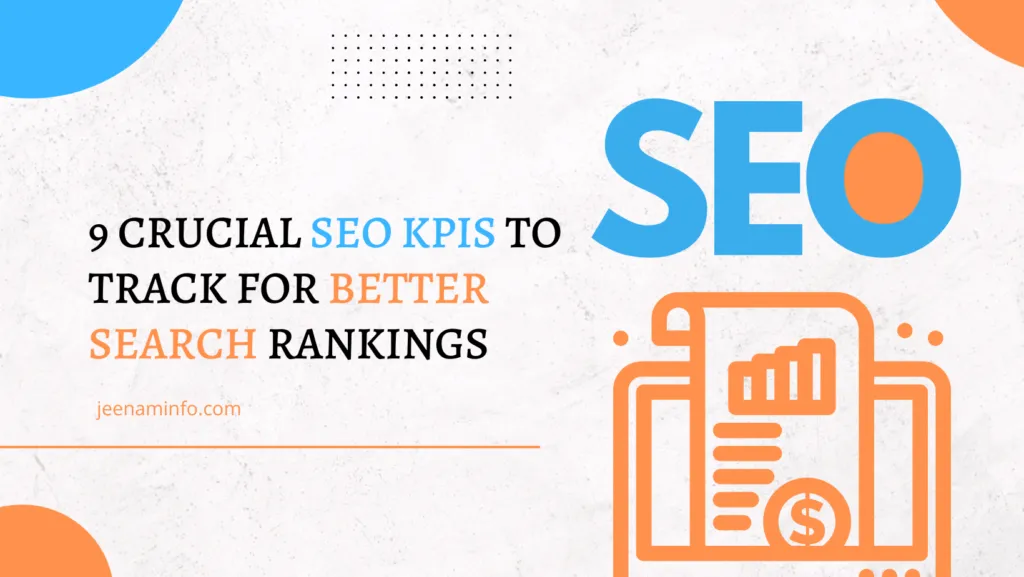Are you looking to boost your website’s search ranking position? If so, you need to understand SEO KPIs (Key Performance Indicators) to stay competitive in the search engine landscape. In this article, we’ll provide a clear guide on important SEO KPIs and how to track them.
Tracking SEO KPIs provide a comprehensive picture of how well your website is performing and areas of strength or weakness.
In this post, you’ll learn about the crucial SEO KPIs you should track. We include each KPI’s purpose, practical tools to use, and best practices in tracking them. At the end of this article, you’ll have a comprehensive understanding of how key SEO KPIs impact your search rankings. So, let’s dive in and unlock the secrets to improving your website’s visibility in search engines.
9 Essential KPIs To Measure & Improve Search Performance
Not all SEO KPIs are the same. Focus on KPIs that are relevant in the long run, actionable, and aligned with your customer journey. While all in the list are important, identify those that affect your goals and keep a closer look at those KPIs.
1. Organic Search Traffic
Organic search traffic measures how many visitors come to a website through search engine results. It helps to see how effective the website’s SEO efforts are in attracting visitors naturally, without paid advertising.
Let’s say your target audience is searching for the target keyword dog training at home. The search engine results will display all websites relevant to the search term. The paid ads usually appear at the top of the search engine results page (SERP), marked as “Ad” or “Sponsored.” While the organic search results appear below the paid ads.
All websites in the SERP are ranked based on their relevance to the search queries and other SEO factors. It would also help to rank higher if you match every piece of content with people’s concerns. In the screenshot above, you can see that most websites at the top rank focus on specific solutions:
- Solving dog behavioral issues
- Techniques to train dogs at home
- Tailoring in-home dog training programs for individual dogs
SEO Tools To Track Organic Search Traffic
You can track organic traffic using web analytics tools. It provides valuable insights into how people interact with a website, where they come from, what actions they take, and more. These tools work by installing tracking codes or tags on web pages to collect data and generate reports. The 3 popular web analytics tools are:
I. Google Analytics 4 (GA4)
Google Analytics is the most widely used web analytics tool. You can access the “Acquisition” section to see the traffic sources and analyze the data. Its ultimate goal is to show where new and returning users come from.
You can filter the data to see the common keywords people search for, organic visitors, and organic traffic volume overview. The screenshot below is what the dashboard looks like for referral traffic.
II. SEMrush
It’s an all-in-one digital marketing tool with an “Organic Research” feature. It will show the keywords that drive organic traffic to your website, including the positions of your website in search results.
It’s also known for being one of the largest keyword research databases on the market. So, using its web analytics will give you a deeper look at the user’s search intent, search volume, and keyword difficulty score.
It can even help you create an effective social media marketing strategy to get your business noticed. Its social media toolkit allows you to schedule and post to multiple accounts, including Google My Business.
III. Ahrefs
Another popular SEO toolset with an “Organic Search” feature. It displays organic traffic data, top organic keywords, and backlink profiles.
Ahrefs also take your site’s health seriously because they offer a strong site audit tool. It examines your site’s technical SEO issues, such as slow site speed, code optimization, and other bad experiences users are facing. After a thorough evaluation, it will provide a health score to determine how serious the issues are. They complete the SEO report with suggestions on how to fix the issues.
When To Track Organic Search Traffic
As a rule of thumb, you should track after you launch your website or begin implementing SEO strategies. This will help establish a baseline for future comparisons.
After that, you should monitor regularly (weekly, monthly, or quarterly). It will help you understand the trends, identify any fluctuations, and spot potential issues or opportunities.
2. Keyword Rankings
Keyword rankings refer to the positions at which specific words or phrases appear in search engine results. This SEO KPI evaluates how well your website or content is performing in search engine listings.
How keyword ranking works depends on the search engine platforms. However, most of them use the following methods to determine the website’s organic ranking in search results:
- Crawling and indexing
- Algorithmic calculation
- Relevance assessment
- Building authority and trust
Knowing where your targeted keywords rank can help you understand how visible your website is to people searching for those keywords. You can then adjust your SEO strategies to further improve your search positions.
SEO Tools For Tracking Keyword Rankings
You can track keyword rankings using SEO tools with keyword-tracking features. Ahrefs, SEMrush, and Serpstat are a few of the popular options. We’ll focus on Ahrefs to give you a clear picture of how it works.
Ahrefs offer a rank tracker tool to make monitoring and tracking rankings simpler. You can input a list of relevant keywords that are important to your website and track their rankings in SERPs. The tool will monitor your website’s positions for each keyword and provide you with regular updates.
This tool also allows you to view historical data, showing how your website’s rankings have changed over time. This helps you identify trends, patterns, and any significant fluctuations in keyword rankings.
You can even compare your website’s keyword rankings with your competitors. It gives you a competitive advantage and helps you identify opportunities for improvement.
When To Track Keyword Rankings
Keep an eye on your keyword rankings regularly. This helps you to identify trends and track progress. It can also spot any sudden fluctuations in rankings that may require attention. You can also track this KPI whenever you do the following:
- During an SEO audit
- Numerous product releases
- Launch a new SEO campaign
- Implement new updates to your website
- Run seasonal or promotional campaigns
3. Click-Through Rate (CTR)
CTR shows you the percentage of users who actually click on your website’s link when it shows up in search engine results. Track it to check if your website’s title and meta description are effectively grabbing people’s attention.
The most common way to determine the actual CTR percentage is manual computation. You can compute it using this simple formula: (clicks ÷ impressions) x 100 = CTR.
Let’s say you have an online store and recently launched a new marketing campaign for your lingerie and nightwear collection. Here’s how you can figure out if your website’s search results are actually hitting the mark (below are sample numbers you received):
- Clicks: 500 clicks from search results
- Impressions: Website’s link appeared in search results 5,000 times
Using the formula, the CTR for your lingerie and nightwear collection would be 10%. It means that out of every 100 times your link appeared in search results, 10 people clicked on it.
Is this a good CTR? The answer will depend on several factors, like the keywords you’re targeting and the purpose of the campaign. But the simplest method to use is by checking your industry average CTR. For fashion and apparel, 6.19% is the average CTR. So, the 10% you get is relatively high.
The result is for the overall CTR. You can also use the same formula if you only want to calculate organic click-through rates.
SEO Tools For Tracking Click-Through Rate
To track CTR, use Google Search Console. You can access the performance report and view the CTR metric. It will show the percentage of people who clicked on your website’s link when it appeared in search results.
It also includes various advanced filters and dimensions. Explore them to learn about CTR for specific pages, queries, devices, and more. This helps you identify trends, patterns, and areas for improvement. Based on your analysis, make the necessary adjustments to your website’s title and meta description.
When To Track Click-Through Rate
CTR also requires continuous tracking. Particularly, whenever you update your website’s titles, meta descriptions, or other elements that appear in search results. It will help assess the impact of those changes. Other specific situations when it’s important to pay attention to CTR are the following:
- Launching a new web page
- Comparing CTR with your competitors
- Actively working on SEO or advertising campaigns
4. Indexed Pages
Track indexed pages to understand how well search engines are finding and recognizing your website. Having more indexed pages means a better chance for your website to show up in SERP when people search for related topics.
One best practice to implement is setting up XML sitemaps, a file that lists all the website pages. It helps search engines understand the structure and content of your site. Here are some best practices to follow when setting up XML sitemaps:
- Make sure that your XML sitemap includes all important pages. This includes your main content pages, blog posts, product pages, and any other valuable pages.
- Structure your XML sitemap logically and hierarchically. It’s best to group similar pages and use sub-sitemaps if necessary, especially for large websites.
- Verify that all URLs are accurate, canonical, and faithfully reflect the actual page locations.
- Along with the URLs, consider including additional metadata for each page in the XML sitemap. This can include information like the last modified date, the frequency of content updates, and the priority of the page.
- Keep the file size reasonable, split large sitemaps into smaller ones, or utilize a sitemap index file if needed.
SEO Tools For Tracking Indexed Pages
Since Google is the most used search engine, Google Search Console became the popular option to monitor indexed pages. It provides information on the number of indexed pages, indexing issues, and insights into how Google sees and crawls your website. You can also view the average position for the entire site, individual pages, clicks by queries, and queries by specific pages.
Index coverage status in Search Console – Google Search Console Training
Other search engine platforms also offer their tracking tool. Bing webmaster tool is one example. It specifically focuses on the indexing and performance of your website in the Bing search engine. It provides data on indexed pages, crawling issues, and other valuable SEO insights for Bing searches.
When To Track Indexed Pages
Check the number of indexed pages at least once a month or every few weeks. Doing so will help you keep an eye on any potential issues and take the necessary actions. Here are other situations when you should pay attention to tracking indexed pages:
- Add or update content
- Make significant changes to your website’s structure
- Technical issues (server errors or incorrect settings)
5. Page Authority
The internet contains a lot of information. Moz developed a scoring system, known as Page Authority, to ensure people will only get relevant and real information. It will also serve as a predictor to know how well a given page is going to rank in Google search results.
As the name describes, Page Authority determines the overall quality and credibility of a webpage using a scoring system. The assessment will be based on the data from the Mozscape web index and other various critical factors (40+). After the assessment, the machine learning algorithm will calculate the score, ranging from 1 to 100.
A higher score indicates stronger authority and better potential for ranking well in search results. The good news is there’s no “ideal” Page Authority score. However, it’s best to aim for a score higher than your competitors.
Let’s say you run a software development website and want to check all your web pages’ credibility. You can place your site’s URL and hit Check Authority. The page will refresh and it will display all the top pages of your website by its actual links.
The homepage lands on the top spot, which isn’t surprising since it’s often the most visited. The rest contains the company’s blog posts. The report also includes your page top keywords, featured search snippets, and competitors.
You can get the list of competitors and conduct another search for competitor analysis. For example, if your company specializes in creating open-source connectors for Postgres change data capture. You can focus the search on companies’ web pages that offer similar open-source connectors for PostgreSQL databases or related services.
When To Track Page Authority
Track Page Authority monthly. However, the specific timeframe may vary depending on your SEO goals and resources. Here are a few scenarios to consider:
- Quarterly tracking: Conduct if you have limited resources or your website’s authority doesn’t change significantly within shorter timeframes.
- Campaign-specific tracking: Recommended for running a specific SEO campaign, such as a content marketing push or a backlink acquisition.
6. Backlink
Backlinks are important in search engine ranking because they serve as a “vote of confidence” for your website. When other websites link to your site, it signals to search engines that your content is valuable and worth recommending to others. As a result, your website is more likely to appear higher in search rankings.
Backlinks come in different formats, but they are often shown in a clickable blue link embedded within an anchor text. The anchor text describes the target webpage to provide context and relevance to the link.
Let’s say you have a blog post about 6 personas of creative agency leaders. Other website or blog owners can use it as a reference for their articles relevant to running a successful ad agency.
SEO Tools For Tracking Backlinks
Tracking backlinks allows you to figure out if the websites linking to your site are reputable and authoritative. In other words, you want to know if those websites are reliable sources of information.
You can use Ahrefs to analyze your backlink profile and identify opportunities for improvement. Here are features you can leverage in its backlink checker tool:
- Link attributes
- Competitor analysis
- Anchor text analysis
- Backlink data collection
- Domain and page-level key metrics
- Backlink overview (external and internal links)
You can generate a backlink report using Ahrefs’ reporting features. Export the backlink data in various formats, such as CSV, PDF, or XLSX. This allows you to save and share the backlink report for further analysis or reporting purposes.
When To Track Backlinks
If you actively engage in link building, it’s crucial to track backlinks shortly after implementing your strategies. This will help you to assess the following:
- Effectiveness of your efforts
- Identify successful link placements
- Make any necessary adjustments to your approach
It’s also a reliable indicator to track backlinks after major search engines released algorithm updates. If you suspect a penalty applied to your website, it’s best to investigate it immediately.
7. Page Load Time
Measuring page load time lets you see how fast or slow a website is in loading its content. Search engines like Google take into account how fast a website loads when deciding how to rank it in search results. They favor websites that load faster because they provide a better user experience.
The ideal loading time for Google is under 2 seconds (average page load times is 3.21 seconds). If a website loads longer than that, it might not appear as high in search results. It will make it harder for a larger audience to find as a result.
SEO Tools For Measuring Page Load Time
Google PageSpeed Insights is the go-to tool for measuring both desktop and mobile page load speed. It also provides suggestions for optimizing your website’s speed.
We use Voila Norbert’s email finder product page on Google PageSpeed Insights to show you how it works. We type in the website URL in the text box and hit “Analyze”.
It also receives a score of 83 for following basic search engine optimization advice and best practices. Overall, the website owner is assured that its potential customers can find their email finder to help them build their email list.
Pingdom website speed test is another excellent free tool to test your website’s performance from multiple locations worldwide. Once the test is complete, Pingdom will display the results on a new page. You’ll see the essential SEO metrics such as loading speed, page size, requests, and more.
When To Measure Page Load Time
The frequency depends on your website’s traffic and how frequently you make changes or updates to your site. Here are a few specific timeframes you may consider:
- During website development
- Before and after major updates
- After implementing performance optimizations
If you’re not performing the above tasks, you can set up a schedule once a month or once every few months. This helps you monitor the performance of your website over time and identify any trends or patterns that may emerge.
8. Bounce Rate
Bounce rate measures the percentage of visitors who are leaving your site after seeing just one page. Tracking this SEO KPI will help you measure the quality and relevance of your website’s content and user-friendliness.
Search engines interpret a high bounce rate as a potential indication of poor user experience, lack of relevance, or low-quality content. They strive to prioritize websites that provide valuable and engaging experiences for users. So, it’s recommended to get a good bounce rate of 40% or lower. Keep in mind that the average bounce rate may vary depending on the types of websites.
SEO Tools For Tracking Bounce Rate
You can use any web analytics for tracking bounce rates. Clicky offers a user-friendly interface. It provides a unique tracking code snippet you can copy and paste into the HTML code of your website’s pages. This code allows Clicky to collect data and track visitor behavior on your site.
After installing the tracking code, it may take some valuable time to start collecting data and generating reports. Once it completes the collection process, you can start analyzing the bounce rate report. The reports include visualizations that show the bounce rate for different pages, time periods, and other dimensions.
When To Track Keyword Rankings
Track the bounce rate every month. This allows you to observe trends and patterns over time, identifying any changes or improvements in user engagement. You can also use the monthly data to assess the impact of optimizations and track the effectiveness of your efforts.
9. Website Design
Search engines primarily evaluate content relevance and quality. However, they also consider website design and structure as important ranking factors. So, strike a balance between aesthetics and functionality.
Create a professional website design with an intuitive user experience and interface to ensure converting potential visitors into leads and customers. Remember to use clean, descriptive, and keyword-rich URLs to help search engines understand the context of your web pages. Here are other aspects of website design that can impact search engine rankings:
- Use persuasive CTAs
- Mobile-friendly websites
- Build engaging homepage
- Aligns with your brand identity
- Design a clear navigation menu
- Make the content more scannable and readable
SEO Tools For Website Design
Yoast SEO helps optimize your website design. It’s a WordPress plugin that helps optimize your website’s on-page SEO. It provides recommendations for improving meta tags, content readability, keyword usage, and more.
Screaming Frog is a great alternative if you want to conduct an SEO audit. It provides detailed information on broken links, duplicate content, page titles, and other on-page elements.
When To Conduct Website Design Checkup
After launching your website, establish a regular maintenance schedule to review and update your web design. This could be quarterly, biannually, or annually, depending on the size and complexity of your website. During these check-ins, you must evaluate the following:
- Overall design
- Assess user feedback
- Address any design-related issues that may have arisen
Conclusion
Improve your website’s search visibility and achieve higher search rankings with effective SEO. Monitoring SEO KPIs gives you actionable insights to make data-driven decisions to enhance your online presence.
To maximize your SEO success rate, you should continuously check your strategies. Regularly assess the impact of your SEO KPIs on your organic visibility, rankings, and keyword searches. You should also optimize your website’s content and URL structure to increase your chances of appearing on SERP’s top page.
Ready to boost your online presence and outperform your competition? Let Jeenam help you analyze your market and competition, and craft a winning strategy for your digital success. Visit our website to start optimizing your website’s content and structure.






